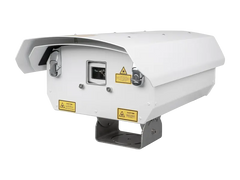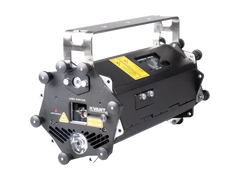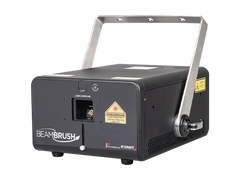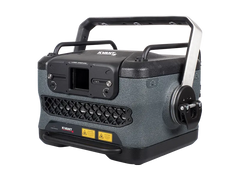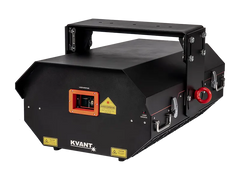WHAT IS A LASER PROJECTOR
To provide a simple definition, laser show projectors consist of any laser system which projects laser light for entertainment purposes. Most entertainment laser projectors (also known as show lasers) generally consist of one or more laser sources (commonly red, green and blue) which are combined together with an optical scanning system and various drive electronics, and then integrated into a laser housing.
This allows for the laser projection of 2D and 3D laser content and objects. Laser projectors (as noted above in the previous sections) can be controlled in a lot of different ways. But most commonly they are controlled from a PC, lighting or DMX console. Laser projectors can also be controlled in stand-alone or “auto-mode”, if they are controlled from an FB4 hardware device.
The front and back of a laser projector
Here you can see the general construction of a professional laser projector. A quality laser projector will utilize an IP54, IP65 or IP67 rated housing. IP54 is suitable for indoor and outdoor events and can withstand mild weather conditions. IP65 is suitable for all outdoor events, and is entirely water resistant. IP67 is completely weather and water proof.
Below you can see the front of a professional laser system.
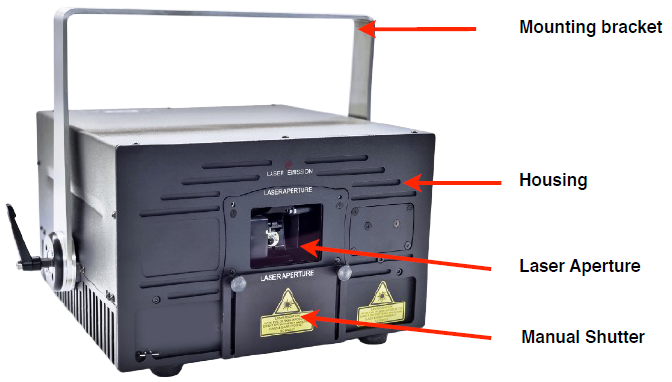
The back of the laser projector
On the back of professional laser projectors, you will see the control inputs, as well as various adjustment and safety options that are commonly available.

The back of newer, higher end professional laser projectors
Laser technology is constantly evolving, and new professional laser systems are now using network based laser controllers like FB4, that get integrated inside of a laser projector. This helps make the setup of a laser show a lot easier, and in addition, makes the control of multiple laser projectors much simpler.
The industry standard network based laser control system is called “FB4”. This laser control hardware is integrated directly inside of the laser, and offers a much greater degree of control possibilities.
FB4 is basically a small computer within the laser, and allows you to control all projector parameters (including colors, safety, geometric correction and more). In addition, it supports all laser and lighting protocols (network, DMX, ArtNet, ILDA, auto-mode) and allows your lasers to more easily interface with other production equipment. It also features a full color display, and onboard memory system with real time clock (RTC).
Newer lasers on the market, will tend to look more like the laser projector below.
Inside the laser projector - How does a laser projector work?
A laser show projector generally consists of red, green and blue laser sources which are combined together with an optical scanning system, dichroic filters, and various drive electronics, and then integrated into a protective housing. A picture is shown below.
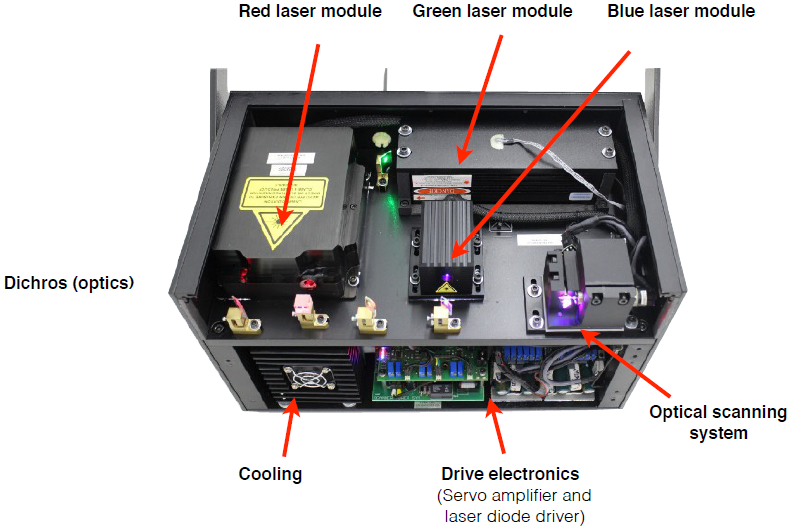
What are laser modules, and laser diodes
A laser module is the light source inside of a laser projector. Think of this like the lightbulb inside of a lamp, the same general principle applies.
Inside of a laser module you have various laser diodes and optics. A laser diode is the component that emits laser light within the module itself.
To offer a bit of history… Laser modules were first introduced as gas laser tubes, that held a specific gas, argon, or mixture of gases and helium-neon. A large amount of power was used to excite the gases and create a laser beam.
This technology later evolved to DPSS, which stands for Diode-Pumped Solid State. DPSS lasers used a very high powered infrared light source, which was then focused onto a specific crystal (Nd:Yag) to create various lasers wavelengths (colors).
Most recently, diode laser technology has become the standard for laser show laser modules. This technology uses an electrical current applied to a laser diode, which is then passed through a laser crystal to create laser light. This has become the standard type of laser module in the laser light show industry, due to the reliability and longevity it offers.
Here is a quick photo of what a professional pure diode laser module looks like (showing both the external housing, and inside the module).

Professional laser modules are completely sealed, so that nothing can get inside and potentially damage or harm the laser diodes, and optics. You will notice that inside of the laser module, we have the laser diodes, and various optics used to create the laser beam.

IMPORTANT: You will also see a component called LASORB, connected to each laser diode. LASORB is a protection device used on professional laser projectors that protects the diodes inside from ESD (electro static discharge) as well as power surges. ESD and power surges are two of the biggest causes of premature laser failure, and LASORB guarantees your laser module and laser diodes, will not be harmed from these elements.
When you buy a laser, you should ask your supplier if their lasers are protected by LASORB. If they are not, ask them to do this. Because it will make a big difference in the overall lifetime of your laser system.
* You can see why you want to have LASORB inside of your module by watching this video:
Another type of laser light source which is common only in very high end laser show projectors, is OPSL technology. OPSL stands for Optical Pumped Solid State, and to put it simply, it offers a very low beam divergence (meaning the laser beam is tighter, and thus, appears brighter). OPSL laser modules are mostly integrated into high end laser show projectors, used for large scale outdoor applications, and stadium sized shows. A picture of an OPSL module and what it looks like inside of its housing, are provided below.

What is an optical scanning system (galvos, scanners, servo amplifier)
An optical scanning system is really the heart and soul of a laser show projector. It consists of two small electronic motors placed inside of a mount on an X and Y axis. Each of the motors has a mirror connected to it, to reflect laser light. And on the bottom of the motor there is a position detector, to receive a control signal from a laser control system. These motors are driven by a servo amplifier.
When the scanners receive the signal from your laser show control system, they move back and forth at very rapid speeds, reflecting the laser light off of them and allowing you to project 2D and 3D laser show images and displays. NOTE - Do not get confused when you see people saying they have a "3D" laser. All laser shows are three dimensional in nature. A "3D" laser show, is just a clever marketing term.
- A “Galvo” is another name for an optical Galvo is the scientific term used when discussing the motor itself.
- A “Scanner” is just another name for a “Galvo”.
The name derived as people saw the “Galvo” scanning the laser beam off of it. - The “servo amplifier” (or amplifier for short) is the drive electronic, used to send the signal to the optical scanning
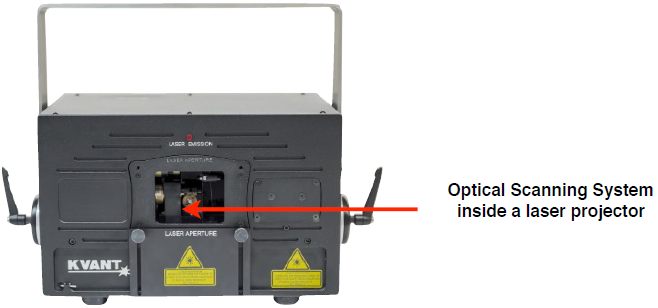
Pictures of the components inside of an optical scanning system
| Galvo or Scanner | Scanners inside of their mount |
 |
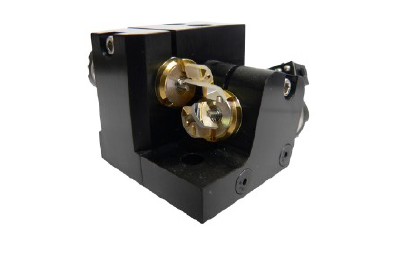 |
| Servo Amplifier (driver) | |
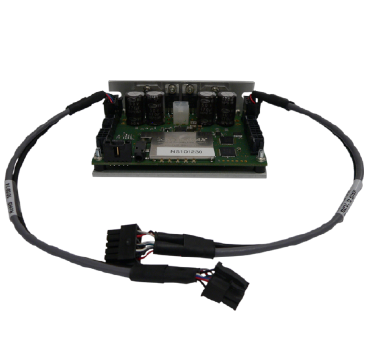 |
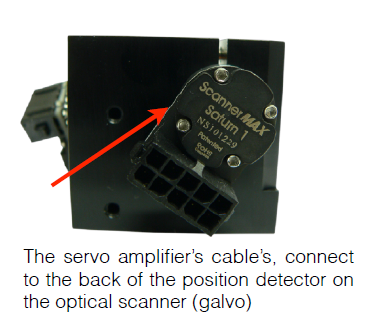 |
This provides a general overview of the critical components inside of a laser show projector. If you have further questions about this, please feel free to contact us directly. As we would be happy to help answer any of your questions relating to laser show technology.


